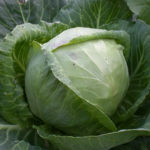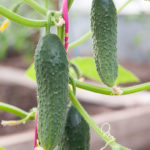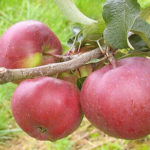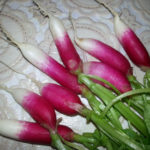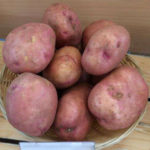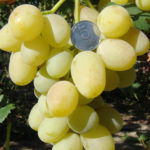Diseases of garden strawberries. Strawberry disease control
In order to successfully grow strawberries on your garden plot, you must first of all know about its diseases and methods of dealing with them.
Gray rot... It occurs most often in conditions of constantly high air humidity. The causative agent of the disease is a fungus. Almost all parts of the plant that are above the ground are affected. At first, blurry brown spots appear on the leaves, then weeping spots on the stalks and ovaries merge together, which can subsequently lead to the drying out of the entire plant. If the weather is humid, the spots are covered with a gray fluffy film - this is conidial sporulation of the fungus. Sick berries look especially characteristic. Soft, rapidly growing spots appear on them, covered with a gray fluff on the surface. The berry itself becomes flabby, watery and tasteless. The causative agent of gray rot is carried by wind and raindrops. Weakened and damaged plant tissues are most often affected.
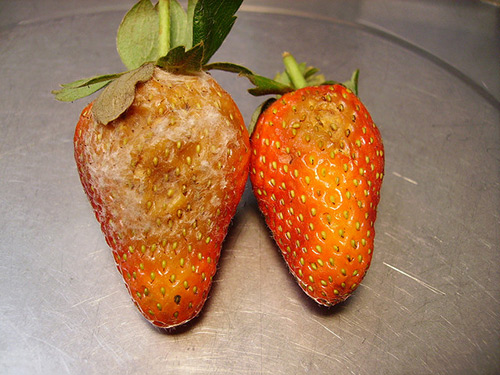
For fight against gray mold it is necessary to carry out a whole range of different measures, because individual measures may be ineffective. It includes:
- preventive sanitary measures, removal and burning of dry affected plant parts;
- growing resistant varieties in places with high humidity;
- planting strawberries in areas well ventilated from all sides;
- balanced fertilization;
- mulching the soil with sawdust, needles or inorganic materials to prevent the berries from touching the ground during their ripening;
- removal and disposal of mulch after complete harvesting, destruction of affected fruits;
- processing before the beginning of the regrowth of leaves with a solution of potassium permanganate
- pollination of the soil with ash or watering with an ash solution to limit the development of the fungus;
- pollination of the root part of the bushes and the soil under them with fluffy lime during the setting of berries;
- planting onions and garlic between strawberry bushes.
White spot... This disease is ubiquitous in wild and cultivated species of strawberries. The causative agent of the disease is a mushroom. Leaves, petioles with inflorescences, and sometimes berries and their stalks are affected. On the leaves, spots can be rounded, brown, at first without a rim. Over time, they turn white in the very center, retaining a bright purple border around the spot itself. This disease more often than others affects old leaves, so the picture of the disease on them is more typical. In diseased leaves, the white center of the spots may fall out. This is a characteristic feature of white spot only. Leaves with a lot of spots can dry out. On inflorescences, petioles and whiskers, spots are elongated, deepened, brown with a lighter center. The disease is spread by wind, rain, and insects. This mushroom hibernates on dry and green leaves, and in spring it settles on young shoots.
White spot control measures:
- destruction of affected leaves, both dry and live;
- autumn cleaning and disposal of all whiskers in the intervals between rows;
- growing only resistant varieties;
- removal of weed varieties that provoke disease outbreaks;
- it is possible to sprinkle with Bordeaux mixture during the growing season, once before flowering, the second after harvesting.
Brown spot... The causative agent of the disease is a fungal infection. Aerial parts are affected - leaves, whiskers and petioles, sometimes sepals. On the surface of the leaves, rounded spots are formed, at first small, then increasing, they are limited by the veins of the leaf itself. The color of these spots is brown or reddish-brown, with a light middle. Diseased leaves look like dried ones. On the surface of the spots themselves, there are very small black convex dots. This is conidial sporulation. The disease is spread by raindrops and insects.The development of the disease is favored by moderately warm weather with high humidity and the ingress of water droplets on the plants.

Brown Spot Control Products:
- disposal of dry, outdated and diseased plant parts in early spring;
- spraying with Bordeaux mixture, the first time - before flowering, the second - after harvesting.
Angular, or brown spotting... The disease is especially harmful in the northwestern part of the Non-Chernozem zone. The causative agent is a fungus. Almost all parts of the plant are affected, except for the roots. On the leaves, the spots are round, purple, the central part of them eventually becomes brown-gray with a purple border. Subsequently, the spots turn into angular ones. Constrictions may appear on the whiskers and leaf petioles, because the spots on them are necrotic. By the end of summer, fungal pycnidia form on the surface of the spots, similar to black dots. Wet weather is especially favorable for the development of the fungus. The disease spreads from one plant to another by drops of water or insects. The pathogen overwinters on infected parts of plants and in the spring infects tissues of young leaves.
Control measures for angular spotting:
- collection and destruction of diseased plant parts in early spring;
- growing only resistant strawberry varieties;
- spraying with Bordeaux mixture before flowering and, the second time, when the crop has already been harvested.
Late blight rot... In addition to strawberries, this disease occurs on vegetables, shrubs and fruit crops. The causative agent is a fungus. Absolutely all aboveground plant organs are affected, but most of all berries. On unripe berries, spots are light brown, dark in the center. They taste bitter, to the touch they are too harsh. On ripe fruits, there are hard leathery spots with a lilac tint. Berries should not be eaten. Outbreaks of late blight occur more often in years with heavy rainfall.
Control measures:
- autumn destruction of all plant residues affected by late blight;
- planting whiskers only from healthy plants;
- upon detection of a disease, the return of strawberry plantings to their previous place no earlier than 6 years;
- spraying with Bordeaux mixture 2 times - before flowering and in autumn.
Powdery mildew... The causative agent of the disease is a fungal infection. All aboveground parts of plants are affected. On the leaves, mainly on the underside, and on the petioles, a white, inconspicuous bloom appears. It can also be in the form of separate spots, which later merge. The leaves stop growing and thicken, coarse and acquire a bronze tint, their edges curl inward. The berries stop developing, then turn brown and dry out. Ripe fruits are covered with a bloom - as if powdered with starch. The disease develops from spring to autumn.
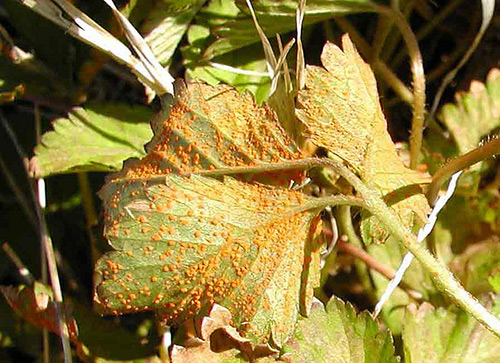
Control measures:
- early spring spraying of strawberries with iron sulfate - 300 g per bucket of water;
- using only pure and healthy planting material;
- timely removal of weed varieties and trimming of whiskers;
- destruction of diseased plant parts;
- spraying with colloidal sulfur, soda ash and copper-soap emulsion during the growing season;
- disinfection of the mustache in a solution of copper sulfate.
Rhizoctonia... This disease is also called black root rot. It affects the roots of not only strawberries, but also other garden crops. Young plants are especially susceptible to it. It manifests itself in the form of wilting and gradual death of the entire bush. The main and lateral roots are affected and die off, parts of the rosettes and leaf petioles rot, as with dry rot. The plant is effortlessly lifted out of the ground. In the soil, the fungus forms rhizomorphs - the plexus of the mycelium, with the help of which it spreads. The disease is transferred from planting materials. This mushroom hibernates in the soil.
Control measures:
- observance of crop rotation, return of strawberries to the same place no earlier than 5 years;
- making only well-prepared compost;
- periodic cleaning and burning of affected plants;
- disinfection of seedlings by immersion in hot water up to 46 ° C for 1 minute;
- treatment with the same drugs as in late blight.
There are also such diseases of strawberries as rugosity, mottling, greening of petals and xanthosis... All these diseases are caused viral infections, most often carried by insects. The main control measures are similar to each other. This is the destruction of aphids, the culling of diseased specimens, the removal of weeds. But the most important thing is to use planting material grown only in special nurseries.
